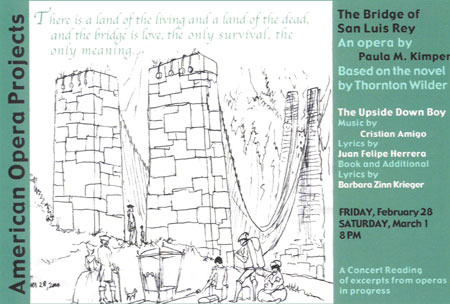by Susan D. Thomas
 This has already been a big year for composer Paula Kimper. On Friday, March 28, American Opera Projects, Inc. presented a concert reading of excerpts from her opera, The Bridge of San Luis Rey. The opera, which Kimper has adapted from Wilder’s Pulitzer Prize-winning novel, traces the lives of five people who are killed in the collapse of a Peruvian bridge in 1714. Their hopes, fears and love are brought to life by a character Kimper calls “The Reader,” who puzzles over the letters, books, and journals which form the lives of these five people.
This has already been a big year for composer Paula Kimper. On Friday, March 28, American Opera Projects, Inc. presented a concert reading of excerpts from her opera, The Bridge of San Luis Rey. The opera, which Kimper has adapted from Wilder’s Pulitzer Prize-winning novel, traces the lives of five people who are killed in the collapse of a Peruvian bridge in 1714. Their hopes, fears and love are brought to life by a character Kimper calls “The Reader,” who puzzles over the letters, books, and journals which form the lives of these five people.
The program notes from the March 28 event describe music as diverse as the five characters’ lives. “The backdrop of the story, the world of geologic time, reflects the forces of nature, wind, birds, and mountain gods, and is expressed with ancient shamanic instruments of the high Andes.” The world of the story itself, that of the Spanish theater, of the Andean Roman Catholic church, of the folk world and of the sea, is portrayed through “18th-century Spanish theater music and opera, Italian masses and secular motets, Spanish and Andean folk music, and sea shanties.” This broad mix of musical genres represents the melodic fusion of culture and story. The Reader, part of our 21st century world, reflects his contemporary point of view in contemporary musical terms.
The libretto, which draws primarily from what Kimper describes as “Wilder’s rich and lyrical prose,” mirrors the opera’s musical variety. “Sermons, poems, lessons, lyrics, reflections [and] anecdotes” are formed from Quechua’s native Andean language, “the Spanish of Calderon, Moretto and Lope de Vega,” and the Latin of the Vulgate. The opening chorus, for example, blends a Spanish Ave Maria with a Quechuan song to [an Andean earth deity].” Thus the opera musically and verbally reflects the mixture of old and new, past and present, Spanish and Andean which so enrich the language of Wilder’s novel.
Kimper is well qualified to undertake such a task. Her first opera, Patience and Sarah, commissioned by the American Opera Projects, had its world premiere at Lincoln Center Festival 1998; it has been produced in Denver and Chicago as well. The opera is due to premiere in England soon. She has composed for film and theater, including the Washington Shakespeare Company’s 2002 production of Much Ado About Nothing and works commissioned by Amy Pivar, the White Barn Theater and the Walt Whitman Project, among others.
The Bridge is always timely. Its investigation into the power of love to connect us to one another, its contemplation of issues of fate and free will and the mysteries which bring people together are timeless. As Kimper, quoted by Kevin Filipski in GO Brooklyn, March 24, 2003, notes “[The story] could be anywhere, anytime, any catastrophe; it could be New York City in September 2001.” Filipski also quotes Charles Jarden, executive director of American Opera Projects, “The plot allows us to think about the [9-11] events.” “By the time those people get to the bridge,” Jarden adds, “we know them intimately.” Wilder’s novel and Kimper’s opera insistently raise the question Jarden notes: “is tragedy random or is it part of a grand plan?” It is the eternal question.
Kimper’s The Bridge of San Luis Rey will be excerpted in a concert reading on Saturday, June 21 at the 1794 Meetinghouse in New Salem, Massachusetts. Information is available at www.1794meetinghouse.org. Kimper also plans a festivity surrounding the event, possibly in mid-June, possibly in New Haven. We will post the information when the date is set.

